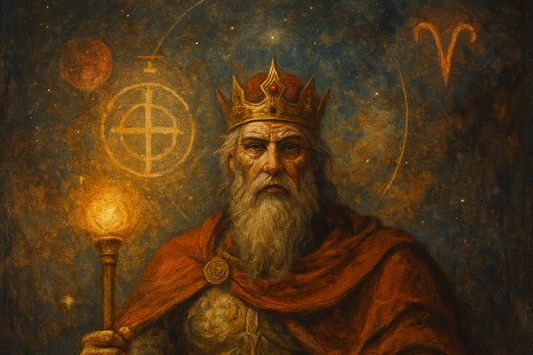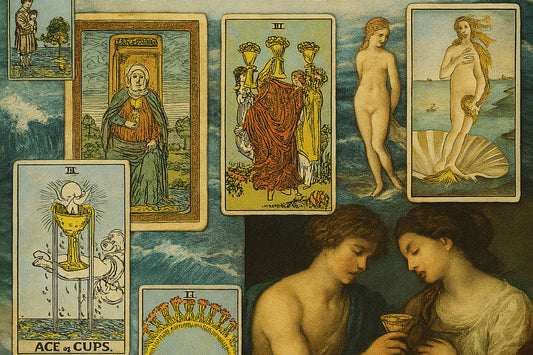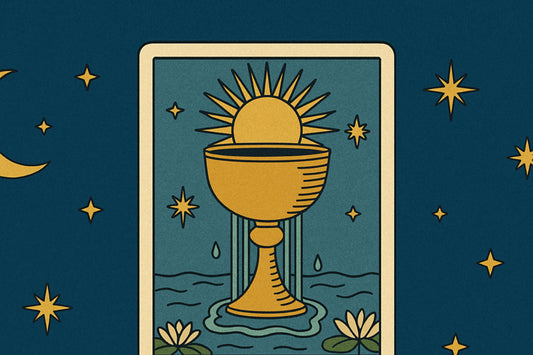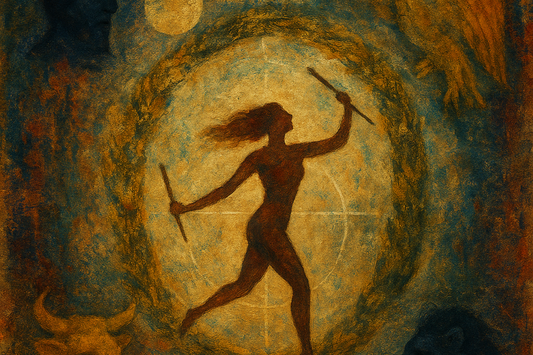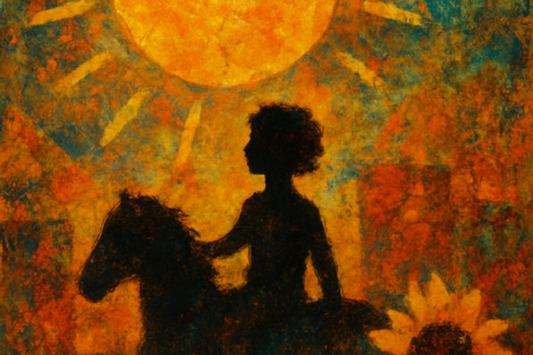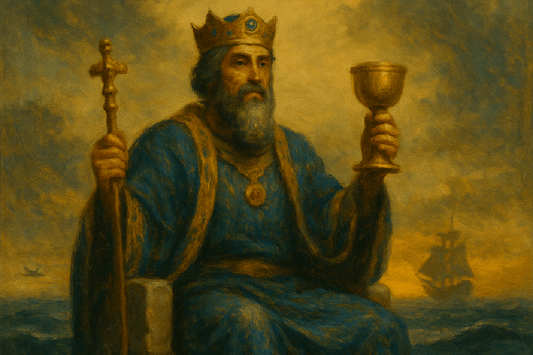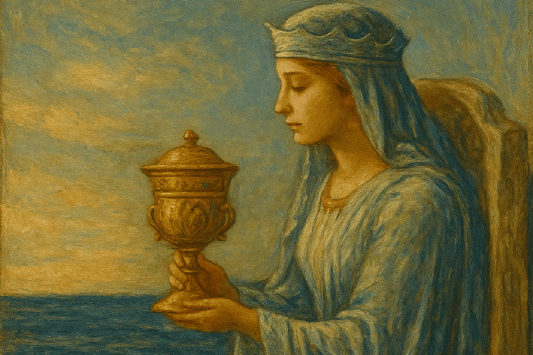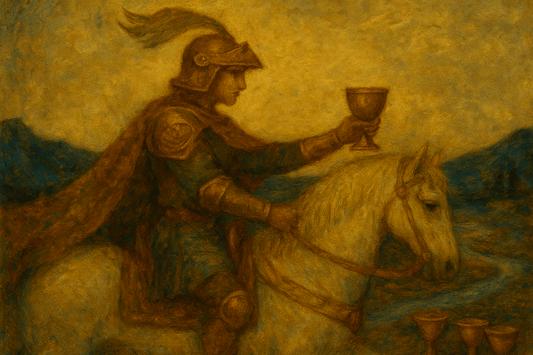The Devil in Tarot: Shadow, Desire and the Illusion of Chains
Tarot AccessoriesTable of Contents
- TL;DR: The Devil Quick Reference
- The Archetype of The Devil in the Tarot
- Symbolism and Imagery of The Devil
- Meaning of The Devil in a Tarot Reading
- Reversed Meaning of The Devil in a Tarot Reading
- The Evolution of The Devil Throughout History
- Numerology and the Number Fifteen in Tarot
- Astrological Resonance of The Devil
- FAQs About The Devil in Tarot

TL;DR: The Devil Quick Reference
Upright: Shadow integration, attachment, temptation, unconscious patterns, liberation through awareness, hidden desires, entrapment, self-sabotage
Reversed: Breaking free, reclaiming power, confronting addictions, facing fears, dissolving illusions, radical self-honesty, spiritual liberation
The Archetype of The Devil in the Tarot
The Devil is not evil. The Devil is entanglement - the moment we confuse attachment for reality and illusion for truth.
He represents the shadow within, the unacknowledged parts of self that, when denied, chain us tighter. His dominion is not damnation - it’s forgetfulness: the loss of conscious sovereignty.
On The Fool’s journey, The Devil is the initiatory confrontation with our own unconscious contracts - the beliefs, addictions, and attachments that masquerade as freedom but are actually prisons.
The Devil doesn't force. He seduces. He tricks you into staying bound - not with chains, but with your own desire for comfort, pleasure, or control.
The invitation is clear: See it. Name it. Own it. Only then can you free yourself.
Related Cards to Explore
Justice in Tarot: Truth, Balance and the Sword of Inner Law
The Hanged Man in Tarot: Surrender, Stillness and Letting Go
Death in Tarot: Transformation, Endings and the Sacred Art of Release
Temperance in Tarot: Harmony, Healing and the Alchemy of Wholeness
Symbolism and Imagery of The Devil
In the Rider-Waite-Smith deck, The Devil appears as a horned, goat-headed figure - an echo of Pan, the god of wildness and instinct. He sits atop a black pedestal, anchoring unconscious material into form.
At his feet, two naked human figures are loosely chained. Yet the chains are wide, loose and technically untethered - they could be lifted off at any time, if only the shyly-shacked would wake up and see the wood from the trees. The Devil tarot card is not enforced bondage - it is chosen blindness, and a nudge to notice it.
The Devil’s right hand is raised in a reversed benediction (mocking The Hierophant), and he holds a burning torch pointed downward - illuminating the descent into matter, not ascent into spirit.
Behind it all: blackness, like that of the alchemical nigredo inherent within the Death card, representing the unlit void of unexamined self, yet to be alchemised.
Meaning of The Devil in a Tarot Reading
When The Devil appears upright, it signals a call to confront unconscious attachments. It invites brutal self-honesty about what binds you - and why you choose to remain bound.
This card often appears:
- In moments of addiction (substance, patterns, relationships)
- When pleasure masks pain
- When external blame hides internal bondage
- During deep shadow work
The Devil doesn’t shame you. He holds up a mirror.
He says: Look. These chains are yours. You can remove them. But first, you have to admit they exist.
Reversed Meaning of The Devil in a Tarot Reading
Reversed, The Devil signals liberation. A loosening of the chains. A willingness to see, to own, to reclaim sovereignty.
This might manifest as:
- Ending toxic cycles
- Choosing truth over comfort
- Radical self-responsibility
- Reintegrating abandoned parts of self
Reversed, The Devil affirms: the door was never locked. You were always free. You just had to notice.
The Evolution of The Devil Throughout History
Origins of the Archetype
The Devil archetype didn’t originate as a figure of cosmic evil. Early representations (e.g., Pan, Dionysus, et. al.) celebrated instinct, wildness, and sensuality.

It was only later, through religious overlays, that the horned figure became associated with temptation, sin, and eternal punishment - a distortion that painted nature itself as fallen.
At its root, The Devil symbolizes unconscious immersion in material reality - not evil, but disconnection from spiritual sovereignty.
Early Tarot Appearances - Le Diable
In the Tarot de Marseille decks, The Devil appears as a monstrous creature, often hermaphroditic, standing atop two smaller figures - echoing enslavement to desire, not external oppression.
The image was raw, strange, even absurd - a warning about the dangers of losing conscious connection to higher self through material attachment.

Yet the figures, even then, could always walk away.
French Occult Tradition - Oswald Wirth and the Shadow Mirror
Wirth reframed The Devil as the force of illusion, unconscious instinct, and the dangers of spiritual amnesia. The horns, wings, and chains were not signs of evil - but of the dangers of forgetting one’s divine origin.
For Oswald Wirth, The Devil was necessary: an initiatory force that must be faced and integrated before true liberation could occur.

The French occultists didn’t moralise The Devil - they understood him as a mirror, a test.
Golden Dawn - Capricorn, the Gatekeeper of Form
The Golden Dawn assigned The Devil to the zodiac sign of Capricorn, which is ruled by Saturn - the planet of structure, limitation, and material mastery.
On the Kabbalistic Tree of Life, The Devil corresponds to Path 26, between Hod (intellect) and Tiphareth (soul). It represents the moment where intellectual pride must be surrendered to spiritual truth.
Capricorn grounds the archetype: not evil, but the weight of form, the challenge of incarnation. Mastery comes not from denial of matter, but from conscious relationship with it.
Rider-Waite-Smith - Chains Made of Choice

In the RWS deck, Pamela Colman Smith and Arthur Waite - both previously Golden Dawn initiates themselves - reframed The Devil with subtle compassion:
- The humans are chained, but loosely
- The Devil is present, but inert
- The real power lies with the figures - if they wake up
It’s not damnation. It’s a sleep - and one we are always capable of waking from.
Waite described The Devil as: “the dwelling place of illusion, where the soul is temporarily bound.”
The Devil's main lesson from henceforth in the tarot is - freedom is not gifted, it’s chosen.
Modern Decks - Shadow Work, Trauma and Reclamation
In contemporary decks, The Devil often represents:
- Unprocessed trauma
- Internalised oppression
- Addiction, co-dependence, self-sabotage
- The necessity of shadow integration for healing
Many depictions reframe The Devil not as an enemy, but as an initiator - the one who forces us to confront where we give away our power.
Numerology and the Number Fifteen in Tarot
Fifteen reduces to 6 (1 + 5) - the number of harmony, choice, and relationship. This is critical: The Devil tarot card, then - is a karmic distortion of The Lovers (card VI).
Where The Lovers (single digit 6) is conscious union and sovereign choice, The Devil is unconscious entanglement and contract.
The Devil's number fifteen asks: What agreements have you made unconsciously? And are you ready to renegotiate them?
Astrological Resonance of The Devil
The Devil is ruled by Capricorn, an earth sign governed by Saturn. Capricorn is ambition, structure, material mastery - but without consciousness, these become prisons.
Saturn teaches discipline and responsibility - but without soul, it becomes oppression.
Thus, The Devil embodies Capricorn’s shadow: attachment to success, status, security at the cost of freedom. But when integrated? Capricorn’s strength becomes liberation through mastery.
FAQs About The Devil in Tarot
What does The Devil mean in a love reading?
In love, The Devil can signify co-dependency, addiction to pleasure, or unhealthy attachment. It may reveal a relationship based more on fear or need than mutual growth. It asks: Are you choosing this freely - or binding yourself unconsciously?
Is The Devil a yes or no card?
The Devil is a pause card. It says: examine motivations before acting. It warns: what you think you want may be a mask for something deeper. Proceed only if you’re willing to be radically honest with yourself.
What does The Devil mean when reversed?
Reversed, The Devil signals liberation. It marks a moment where you see the chains, name them, and begin to loosen their hold. It is the start of self-reclamation - the beginning of real, embodied freedom.
What archetype does The Devil represent?
The Devil is the archetype of The Shadow Holder. The one who mirrors our unconscious contracts. Who tempts not to trap - but to test.
He is not your enemy. He is the gatekeeper you must see through to reclaim your soul.


